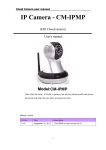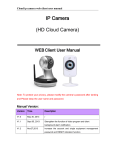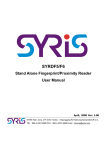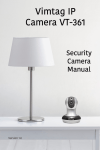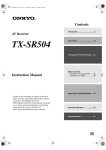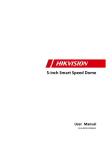Download IP Camera
Transcript
FI - 361 user manuals IP Camera (HD Cloud camera) User's manual Model:FI-361 Note: After landing in order to protect your privacy, please modify the factory password, and take good care of the user name and password. Manual version: Version Date description V1.0 September 16, 2012 IPC1 revised version of A1 Note: in practical application, it is possible to instruction function to the user the hands of the function of the machine have access. 1 FI - 361 user manuals Content Product Overview .............................................................................................................................4 Packing List. .............................................................................................................................4 System Requirements................................................................................................................4 Introduction...............................................................................................................................4 Features .....................................................................................................................................5 Overview of the Hardware view ...............................................................................................6 Installation.........................................................................................................................................7 Hardware Installation................................................................................................................7 Camera Installation Wizard.......................................................................................................8 Wireless Installation Considerations .......................................................................................11 Home page ......................................................................................................................................13 One .Camera status bar: ..........................................................................................................13 Two. Image settings and PTZ control bar. ..............................................................................14 The recorded single frequency ................................................................................................15 Playback..........................................................................................................................................15 Log ..................................................................................................................................................16 Management....................................................................................................................................17 One. Product information:..................................................................................................17 Two . User ...............................................................................................................................18 Equipment nickname.......................................................................................................18 Password: ........................................................................................................................18 Three. Media stream: ..............................................................................................................19 Stream .............................................................................................................................19 Image: .............................................................................................................................19 Framerate ........................................................................................................................19 Four. Network .........................................................................................................................20 1. Ethernet: ......................................................................................................................20 2. Wireless Network:.......................................................................................................21 Five. Servers ...........................................................................................................................22 IP address ........................................................................................................................22 Six. Media transfer:.................................................................................................................23 Transfer Protocol:............................................................................................................23 Seven. PTZ..............................................................................................................................23 Speed...............................................................................................................................24 Eight. OSD:.............................................................................................................................24 Display Name..................................................................................................................25 Display date.....................................................................................................................25 Date format .....................................................................................................................25 Display week...................................................................................................................25 Nine.Audio:..........................................................................................................................26 Speaker............................................................................................................................26 Microphone .....................................................................................................................26 Ten.SD card:.........................................................................................................................27 2 FI - 361 user manuals Status............................................................................................................................... 27 Capacity: .........................................................................................................................27 Usage: .............................................................................................................................27 Eleven. Alarm: ........................................................................................................................28 External input arming:.....................................................................................................28 IO linkage:.......................................................................................................................28 Twelve.Date/Time ...................................................................................................................29 Date:................................................................................................................................29 Time: ...............................................................................................................................29 Automatically synchronized with the time server:..........................................................29 Time server address:........................................................................................................29 Thirteen .System maintenance: ...............................................................................................30 Online upgrade................................................................................................................30 Restore the default settings: ............................................................................................30 Restart the device:...........................................................................................................30 Troubleshooting ..............................................................................................................................31 Wireless Infrastructure ....................................................................................................................34 Wireless Security ............................................................................................................................36 Specifications..................................................................................................................................37 3 FI - 361 user manuals Product Overview Packing List. 9 9 9 9 9 9 9 9 1 set of network cameras An Ethernet cable A 5V power adapter Disc 1 piece Quick Installation Guide Bracket (base) and mounting set A Wireless antenna A warranty card Note: The use of non-product rated voltage power supply, will result in equipment damage, and does not enjoy the product warranty. Of above items if something is missing, contact your dealer. System Requirements • With Microsoft Windows ® 7, Vista ®, XP ®, Mac OS or Linux system computer • CPU clocked at 1.3G or higher, at least 128MB of RAM • Internet Explorer 7 or later, Firefox 3.5 or later, Safari 4 and Chrome 8.0 or later. Introduction Congratulations on your purchase of the Cloud CAMERA.The Cloud CAMERA has multiple functions, is dedicated to the small office and home solutions.Unlike traditional IP CAMERA, Cloud CAMERA has a complete system with built-in CPU and web server, can transmit high-quality images, the implementation of the security monitoring. Cloud CAMERA from any computer or laptop via a local network or the 4 FI - 361 user manuals Internet using a web browser to access and control; their installation is simple, intuitive user-friendly WEB interface settings, can be combined with 802.11b/n/g wireless network perfect . The Cloud CAMERA also has a remote monitoring and motion detection function, making it a complete, cost-effective home security solution. Features 9 Can support H.264/MPEG4/MJPEG stream, suitable for Local, Internet access as well as cross-platform; 9 CMOS sensor, support 1280 * 720,640 * 360 , 320 * 180,160 * 90 real-time video encoding; 9 Support the smartphone anywhere to watch the video screen, support Windows Phone, Android system smartphone / IPHONE phone / IPAD devices to ensure that the image smooth / no stumble.. (25 image transmission can watch 720P HD image); 9 P2P technology-free configuration plug-and-play (no need to do port mapping , DNS, IP address settings) 9 A key WPS easy wireless connectivity, privacy features, arm function. 9 Intelligent transmission technology (bandwidth adaptive, code rate adjust dynamically , the priority voice, jitter buffer). 9 Support two-way voice intercom, the use of carrier-grade signal processing (echo cancellation, noise suppression, voice equalizer, comfort noise sound, silence suppression). 9 Support the SNS social networks, openid (QQ, facebook landing) 9 Supports firmware remote upgrade (automatically prompt the latest version). 9 Access to support multi-users, multi-device managements. 9 Two-dimensional code landing, each machine has a unique ID number and password. 9 Financial level encryption protection, (using RSA/DH/DES/MD5/SHA/CRC/BASE64 encryption algorithm). 9 Support cloud storage technology. 9 Alarm linkage/ Push, transfer video and pictures by E-mail, FTP; SMS alarm notification methods. 9 Support motion detection, and can be an external alarm detector, t to achieve the comprehensive protection; 5 FI - 361 user manuals 9 Support more than one type of browser viewing device video, such as IE / Firefox / Safari / Google Chrome, etc.; 9 Support for Flash Player, Quicktime, Realplayer, VLC, The Mplayer player direct access to the camera. 9 Own PTZ ,support level of 320 ° and 120 ° range of rotation of the upper and lower; 9 Infrared LED for night vision range of 10 meters, whole day monitoring; support IRCUT, day / night filter switch, Image unbiased color; 9 Built-in wifi modules, and the flexibility to set up wireless monitoring environment; 9 Maximum support 32G SD card storage, alarm photographed and alarm video; 9 Support POE power supply (compliant with the IEEE the standard 802.3 standard). (Optional) Overview of the Hardware view Photosensitive sensor Len IR LED microphone Status Light Status Light STATE1 POWER LED 6 STATE2 FI - 361 user manuals Reset loudspeaker FN composite button WIFI Antenna DC5V Power SD card Port Ethernet External interface input/output Audio input/output interface interface Note: short press the reset hole reset key is to restart function; Long press the reset button to 5 seconds, is the factory default. Installation Hardware Installation Connect the network cable and power Wired: Attach the Ethernet cord into the Ethernet port behind the IPCAM and the other end into the router and other network equipment,to access network. Wireless: The packaging comes with a wireless antenna Installed to IPCAM behind the "ANT" interface. Packaging wife an external power supply plugged into the wall power outlet or Line board, then the power of the DC head into the network behind the camera DC power input interface, when the network in front of the camera 7 FI - 361 user manuals POWER indicator lights up in red, indicating that the normal supply of electricity. Connect an external alarm interface and an external audio Connect the External I / O alarm input / output. External audio input / output interface: MIC and headphone connectors respectively mounted external 3.5 inch AUDIO IN AUDIO OUT inserted into the rear of the machine Camera Installation Wizard The first step to configure the network connection: 1.Wired internet: IPCAM connected to the power supply and cable networks, the front of the machine"POWER" light a long red light. 'STATE2 "lights turn red, Wait 20 seconds, into a green light flashes (every 3 seconds flashing 7 times) Self-test one revolution IPCMA PTZ center. 8 STATE2 indicator light FI - 361 user manuals 2. Wi-Fi: You can use the WI-FI Protected Setup (WPS) button for Camera to create wireless connection. IPCAM connect electric and start, a: press the "FN" button for three seconds under the rear of the machine, then STA2 green LED indicator light began to flicker. b: press the WPS button on the router in 60 seconds, WPS button is usually in the front or side of the router. Some FN button routers,You may need to log into the web interface, click the button on the screen to WPS characteristics. If you are not sure whether your router has the WPS button, check the user manual of the router. After a successful connection , The green light of STA2 flashes (every 3 seconds flashing 7 times). Note: The router's DHCP server function must be enabled. The second step landing: A: Open the browser, http://www.mipcm.com/, in the address bar, enter the following figure, the login screen, enter the ID number and password of the machine (each IPCAM are labeled with a unique ID number need to scratch off the squeegee and password ). Note: After landing in order to protect your privacy, please modify the factory password, and take good care of the user name and password. Mobile client software to download language option Input ID number or registered account Enter Password 9 The registered account user FI - 361 user manuals Note: The user can click on the login screen "Register" button to register a user to manage multiple cameras after landing. B.Go to the video viewing interface. Registered interface users landing Use ID landing interface Click the play button C: install plug-ins: 10 FI - 361 user manuals Click on the install plugin Note: If the user's router is not connected to the Internet, users can watch video via LAN. Running the searching tool in the CD-ROM to search the IP address of the IPCAM. .Double-click the IP address into the login screen. If you watch the video image blurring ,maybe the camera lens and CMOS sensor is not a good focal ,please let the camera aim at the object away from 5 meters, slowly to turn the lens repeatedly and slowly by hand until the image be the most clear. Wireless Installation Considerations IPCAM wireless cameras allow you anywhere in the wireless coverage area by using a wireless connection to access the network. However, the wireless signal is required to pass through the walls, ceilings and other objects in the number, thickness, and position will limit its scope. Usually coverage changes, depending on your room or office type of building materials and environmental RF (radio frequency) noise. Follow these basic guidelines is the key to maximizing wireless range: 1. The Wall, ceiling between the routers and other network devices (such as network cameras) minimize the number - and each wall or ceiling will weaken adapter 3-90 feet (1-30 meters), wireless transmission range. 2. Please note that the straight-line distance between the devices. A 1.5 feet (0.5 meters) thick wall angle 45 will reach 3 feet (1 meter) thick. 2-degree angle, the 11 FI - 361 user manuals wall thickness up to 42 feet (14 meters). To place the device into place straight through the wall or ceiling (instead of angle) in order to get better reception. 3. Building materials caused by the difference. The metal door or aluminum skeleton will weaken the wireless signal. Placing the access points, wireless routers and other network equipment to the signal through the drywall or open doorways. Materials and objects, such as glass, steel, metal, band insulator, water (fish tanks), mirrors, file cabinets, brick and concrete walls will weaken the wireless signal. 4. The product was placed in a position at least 3-6 feet or 1-2 meters away from generating the RF noise of electronic devices and appliances. 5. If you are using 2.4GHz cordless phones or other radio emitting source equipment (such as microwave ovens), your wireless connection may obviously deteriorated or completely dropped. Put the 2.4GHz phone base away from the wireless device as far as possible. Even if the phone is not using the dock will still transmit signals. 12 FI - 361 user manuals Home page Logged in, displays the home page, click on the Play button, and display real-time video images. Double‐click the video to watch window, can full screen display: One .Camera status bar: 1. Here, you can see the online status of each camera. Online status for the following categories: • Green means that your camera is online and ready. • Yellow means the camera online, but the camera password has been changed. You need to enter a new password in order to access the camera again. • Red indicates the camera is offline and not accessible remotely. 1. If the camera is offline, try the following approach: • Check to make sure the camera's network connection is normal. • Try restarting your network router. • Check the camera cable connections to ensure that they are secure connection. • Check and confirm the camera STATE2 green light flashes flashing (every 3 seconds flashing 7 time ).If you still cannot access your camera, the camera is rebooted. 13 FI - 361 user manuals 2. : Searchable the IPCAM within the local LAN, add the outer IPCAM and manage the cameras have been added. 3. : The status bar to show and hide icons. Two. Image settings and PTZ control bar. 1. : Exit the video interface. 2.Brightness: adjust the brightness level of the video screen. 3.Contrast: adjust the video screen contrast level. 4.Saturation: adjust the video screen color saturation level. 5. 6. 7. : PTZ control IPCAM up / down / left / right rotation. : Control the size of the voice of the computer speakers. : Status bar display and hide the icon. Three. Interface buttons: 1. Video play / pause button: Click button on the video image playback / pause. Click on the inverted triangle button, select playback image resolution (1280 * 720,640 * 360,320 * 180,160 * 90). 2. Record button (the recorded files are stored-FLASH card): Click button on the audio / video recording , the recording icon indicates. Click on the inverted triangle button mode to enter the : The plans record: option, 7 days a week, 24 hours is not checked Intermittent video and regular video. Alarm Recording: When checked, the implementation of the alarm video Optional I / O alarm mobile investigative Alarm. Length of time "refers to the pre-recorded pre-recorded trigger ,video before the video can be directly input time 14 FI - 361 user manuals Seconds unit. 'Duration "refers to the reported, the police recording time can be directly input time, Seconds unit. The recorded single frequency: When optioned , sound recording when the alarm recording. 3. Snapshot button: Click the button to capture images of the video being played. Click on the inverted triangle button, selectable camera picture resolution (1280 * 720,640 * 360,320 * 180,160 * 90). 4. Intercom: click buttons, camera and computer microphone / loudspeaker war, the two sides can voice intercom, dual to each other, we can hear each other's voices. Playback Play SD CARD-recorded video files. Camera list Video file query and directory list Progress bar and queries to the video file number fast reverse Prev play/pause next Fast Forward 1. Select the camera in the camera List. 2. Queries the video files , documents and more information on the right in the image by time. 15 FI - 361 user manuals 3. After Inquire, the progress bar will be displayed by color length query to the video file, specify the video player can be selected directly by dragging with the mouse. 4. A video file / rewind / playback video files can be realized by player image control keys to play, pause / play a video file / fast forward Log Log is a chronological log of users the IPCAM all information Camera list 1. Select the camera in the camera List. 2. Start time: i select open time. 3. End time: select the end time 4. Select a state. 5. Query 16 FI - 361 user manuals Management This section of the configuration of the camera settings. One. Product information: Display the basic information of the camera. Modify registered users password Model: The model of the camera. Firmware version: the camera software firmware version number. Plug-in version: the camera video viewing plug-in version number. Device serial number: ID number of the camera. 17 Quit, returns to the landing interface FI - 361 user manuals Two . Equipment Modify camera equipment password. Equipment nickname: the name of the camera, the user can according to their own requirements to change the name. Password: modify the current camera to enter the login password of the current camera New Password: through here, the user can enter the current camera landed a new password. (To protect your privacy, after landing modify the default password, and please take good care of the user name and password.) Confirm Password: Re-enter the password of the current camera modified. Click Apply to save your changes. 18 FI - 361 user manuals Three. Media stream: Audio / video stream bit rate settings. Stream: the video stream is were high (HD) / normal (normal) / half (half) / (min) four, and their corresponding resolution of 1280*720, 640*360, 320*180, 160*90.Different stream, Framerate / bitrate / I frame interval set. Image: Resolution: The resolution of the image display. Select a different stream, corresponding to the different resolution. Framerate: the number of images per second, fps.The larger the frame rate, the more fluent image. Bit rate: bps unit. Bit rate, image display more clear, but the highest occupied network resources. The user can set a maximum and minimum values. I frame interval: send each keyframe interval. Audio: Encoding types: audio encoding, G.711, G.726, AMR, AAC four encoding Sampling rate: refers to the frequency of the audio samples. Click Apply to save your changes. 19 FI - 361 user manuals Four. Network NIC: Ethernet (wired) and wireless networks. 1. Ethernet: Effective when connected to a wired network. Startup Status: Displays the current Ethernet enable / disable. Mac address: Displays the current Ethernet Mac address. Automatically obtain an IP address (cameras default): select camera Machine automatically get connected to the router and it is automatically assigned to IP address / gateway / subnet mask information. Use the following IP address: Check the user manual allocation One IP address / gateway / subnet mask to the camera. Dns server address automatically exercised: Check, camera Automatically get to be automatically assigned to the router connected to it Its DNS information. Following dns server addresses: user Manually assign DNS to the camera 20 FI - 361 user manuals 2. Wireless Network: NIC choose a wireless network. Startup Status: Displays the current wireless network, enable / disable. Wireless mode: hot / terminal A. Hot spot: as the default search equipment, network cameras, wireless hot mode, wireless devices through wireless search, Point-to-point connection to the camera. DHCP: Dynamic Host Configuration Protocol for wireless hotspots, starting address to the end the address and gateway. B. Terminal: As search equipment. Connection Status: Displays the status of the wireless network. Select Network: Wireless will automatically search for the cameras surrounding the wireless network terminal in the drop-down list, select the wireless network terminal. Password: Enter the password for the wireless network equipment. Click the connect button to connect the selected wireless Click Apply to save your changes. Mac address: displays the current wireless network Mac address. Automatically obtain an IP address (cameras default): select camera Machine automatically get connected to the router and it is automatically assigned to IP address / gateway / subnet mask information. Use the following IP address: Check the user manual allocation One IP address / gateway / subnet mask to the camera. Dns server address automatically exercised: After checked, camera Automatically get to be automatically assigned to the router connected to it its DNS information. Following dns server addresses: After checked, user Manually assign DNS to the camera. Click Apply to save your changes. 21 FI - 361 user manuals Five. Servers IP address: the camera is connected to the server's IP address. Click Set to save your changes. 22 FI - 361 user manuals Six. Media transfer: Transfer Protocol: drop-down list have RTMP, RTSP, RTDP, MUTP, four transport protocol, select AUTO (the default protocol RTDP). RTMP: port 7010, do not install the plug when viewing images with this agreement. RTSP: port is 7020, this agreement play equipment suitable for streaming media player (such as QuickTime and VLC Universal Player) video. RTDP / MUTP: ports 7030/7040, private P2P video streaming protocol. Click Apply to save your changes. Seven. PTZ PTZ rotation parameter settings. 23 FI - 361 user manuals Speed: PTZ speed parameter settings, the greater the value, the PTZ faster. Click Apply to save your changes Eight. OSD: Image screen display menu settings. 24 FI - 361 user manuals Display Name: After checked , will display the name of the camera in the top left corner of the screen. Name: The user can modify the screen displays the name of the camera. Display date : After checked , will display the date of the camera. Date format: User can select year / month / day or month / day / year both date formats. Show time: After checked , will display the time of the camera. Time format: user can select 24-hour or 12-hour system. Display week: Check the upper left corner of the screen displays the day of the week. Click Apply to save your changes 25 FI - 361 user manuals Nine.Audio: Speaker: Set the camera the size of the sound from the speakers, use the mouse to drag the slide bar, the greater the value, the greater the sound from the speaker Microphone: Set the sensitivity of the camera microphone, use the mouse to drag the slide bar to set, the greater the value, the more sensitive microphone receiving sound external environment, the greater voice of the monitored computer end, accordingly, the greater noise of the monitored environment. Click Apply to save your changes. 26 FI - 361 user manuals Ten.SD card: Display the status of the camera SD card. Status: Displays the current SD card plugged into the camera and whether it has been read to the camera. Capacity: Show the total size of the plug into the camera's SD card. Usage: displays the current plug into the SD card in the camera has been used in the situation. Click Apply to save your changes. 27 FI - 361 user manuals Eleven. Alarm: External input arming: trigger signal input, an external alarm sensor probe (such as smoke alarms probe).Checked mode depending on the type of external alarm probe equipment to select normally closed or normally open. IO linkage: the alarm trigger signal output, external alarm equipment (such as speaker equipment). Checked, the machine triggered the alarm linkage output alarm signal to trigger external alarm, normally closed or normally open mode depending on the type of external alarm devices. Click Apply to save your changes. 28 FI - 361 user manuals Twelve.Date/Time Date: the date of the camera can be manually modified. Time: time of the camera can be manually modified. Automatically synchronized with the time server: after checked , the camera time is automatically synchronized with the server time. Time server address: the address of the time server. Click Apply to save your changes. 29 FI - 361 user manuals Thirteen .System maintenance: Online upgrade: If you have the latest software will prompt <update> click update, the camera will upgrade the software online. Note: Software upgrade on the camera there is a certain risk, software upgrade and cannot cut off the network, or they can put the machine up dead. Restore the default settings: click the restore button, the camera will be restored to the factory default settings, the user will cancel the camera settings made. Restart the device: click on the reset button to restart the camera. Click Apply to save your changes. 30 FI - 361 user manuals Troubleshooting This chapter provides solutions to problems that may arise in the IP CAMERA install and running. If you encounter problems, please read the following description. (The following example is based on Windows ® Vista ™ and XP Description If you are using a different operating system, your computer screen and following a similar example.) 1. What is remote access? How do I enable it? Through remote access, you can use a web browser from any PC connected to the Internet to access the camera. So even if you are not at home, you can watch the camera images, and manage the camera settings. To enable remote access, you can simply follow the Quick Installation Wizard. If you are not connected on the camera, make sure the following items: ....The green LED camera on SETATE2 green light flashes (every three seconds shiny 5 times). ....Network connection is working properly ... Router's LAN & WAN connection is working properly. ... The router has enabled UPnP. ... The router can get a public network IP. ... The router has been upgraded to the latest firmware version. ... You have tried to restart the router by unplugging the power and then plug it in again the way After the completion of the inspection of the above, you can re-landing. 2. Why photo camera's network connection unreliable? The network cable may be a problem. Make sure the cable is working, PING network known address of the device. If the cable connection is correct and your network connection is working, you should receive a similar (bytes = 32 time = 2 ms) reply. Another possibility is that the network camera network devices such as hubs or switches, there is a problem. Make sure that the power for all devices are connected and working properly. 3. Why Network Camera work locally, but the remote does not work? This may be caused by the firewall protection, and your system administrator to check network firewall. The firewall may need to make some configuration changes, in order from your local LAN, external access to the network camera. For more 31 FI - 361 user manuals detailed information, please refer to the relevant sections of the cameras installed in the router backend. Ensure that the network camera does not conflict with any Web server running on your network. The default router setting might be the problem. Make sure that the router settings configured to allow external access from your local LAN network cameras. 4. Why the image on some of the vertical white line? There may be a CMOS sensor due to exposure to light (such as direct exposure to sunlight or a halogen light) and overload result. The CMOS sensor is located in the rear of the lens, its role is the measurement light signal and converts it to a digital format so that the computer will digital format in the form of an image presented to the user. CMOS sensor is a long time in the bright light , the network camera cannot be immediately transferred to a dark area, so as not to damage the CMOS sensor. . 5. The camera blurred image, how to solve? If the network camera work where light is dim, the video image may become blurred. Another possibility is that the camera lens and CMOS sensor not good focus, the camera aligned 5 meters away from the object, turn the lens slowly by hand repeatedly adjusted until the image is most clear. 6. The image quality is poor, how to improve the image quality? Determine your computer's display properties set at least six colors.16 or 256 colors makes the image appear jitter artifacts, it seems the quality will be poor. Network Camera image display is not configured correctly. Configuration through the Web Management Web video interface, you can adjust the parameters to improve the image quality, these parameters include: brightness, contrast, and color saturation. 7. Why no images on the Web browser? The ActiveX might not enabled. If you are through Internet Explorer to see the image, make sure to enable ActiveX in the Internet Options menu. You may also need to modify the browser's security settings to allow installation of ActiveX plug. If you are using Internet Explorer version is less than 7.0, you need to upgrade to a Web browser, in order to watch the video sent by the network camera. 8. Troubleshooting, LED status indication: Indicator POWER (red light) Indicator flashing frequency Long bright Status normal Power supply STATE1 (red light) 32 FI - 361 user manuals STATE1 (green light) STATE2 (red light) STATE2 (green light) flash 2 times every 3 seconds SD card connected flash 2 times every 3 seconds Did not get to the IP address flash 2 times every 3 seconds Connected on the router, but not connected to external networks flash 5 times every 3 Wired is connected to external seconds networks, and can be accessed remotely flash 6 times every 3 seconds Wireless connection on the outside network, remote access 33 FI - 361 user manuals Wireless Infrastructure IP CAMERA wireless products are based on industry standards for your home, business or public access wireless network to provide a simple and compatible high-speed wireless connection. The IP CAMERA strictly follow the IEEE standard, wireless products allows you anytime, anywhere secure access to the data you need. You will be able to enjoy the freedom of the wireless network. Wireless LAN (WLAN) is a unit of the computer network by a wireless signal instead of wires to transmit and receive data. WLAN is more and more used in home and office environments, as well as public places such as airports, coffee shops and universities. WLAN technology in innovative ways to help the character work , and communicate more effectively. No cabling and other fixed infrastructure, as well as better mobility provides more convenience for many users. In many environments, the mobile network equipment needs to be connected to a conventional Ethernet LAN, in order to use servers, printers or an Internet connection via a wired LAN. The wireless router is used to provide such a connection device. What is wireless? Wireless or WiFi technology is not using a cable to connect your computer to a network. WiFi uses radio frequency to connect wirelessly, so you can be free to connect computers anywhere in your home or office network. Why buy IPC1 wireless equipment? IPC1 is the world's leading real smartphone remote monitoring network camera products, can get the smoothly and clearly video. And access the real P2P technology. IPC1 products at reasonable prices, and excellent performance. How does the wireless network work? Similar with wireless phone when the wireless network work , through radio signals to transmit data from point A to point B. However, a wireless network have some restrictions on how you access the network . You must be the coverage of the wireless network, in order to connect to your computer. The wireless network is divided into two different types of wireless local area network (WLAN) and wireless personal area network (WPAN). Wireless local area network (WLAN) 34 FI - 361 user manuals In wireless local area network, the access point (AP) as a computer to access the network device. The access point has a small antenna, whether through radio signals to transmit data. Indoor access point shown in the drawing, the signal can reach a distance of 300 feet. In outdoor access point signal distance up to 30 miles .Can be used such as a factory floor, industrial areas, college and high school campuses, airports, golf courses, as well as many outdoor occasions. Which kind person are suitable for wireless network? Increasingly popular wireless network technology in recent years, almost everyone is using it, it can provide wireless solutions for the home, office and business, D-Link. Home • provide for everyone at home broadband access. • browse the web, view email, instant messaging, etc. • No cable connection in the room around • Simple and easy to operate SOHO (Small Office and Home Office) • When you at home are as in the office .everything will be in your hands • Remotely access your office from home. • Multiple computers to share an Internet connection and a printer • Does not require a dedicated office space Where to use the wireless network ? Not just confined to the home and office, wireless technology is being extended to every corner. People like the freedom of mobility, wireless networks are becoming increasingly popular, more and more public places began offering wireless access to attract people. The wireless connection in public places is usually called "hot spots". Use a wireless card in your laptop, you can be in distant places such as: airports, hotels, cafes, libraries, restaurants and conference center with wireless network. The wireless network is easy to install, if you first installed, you will need to work hard to understand where to start. This is why we want to provide some of the installation steps and tips to help you complete the installation process for the wireless network. Prompt 35 FI - 361 user manuals When you install a wireless network, please note the following: Post your router or access point on the center place of the network. Verify that your router / access point on the center position of the network, in order to get the best results. Try to place the router / access point to the highest point in the room, so that the signal can be distributed to your room. If your home is a two-story building, you need to install the repeater signal expanding coverage. Eliminate interference Household appliances, such as cordless phones, microwaves, and televisions as far as possible from the router / access point. This will greatly reduce the electrical interference caused by the work at the same frequency. Safe Prevent your next door neighbors or intruders connect to your wireless network. Open the router's WPA or WEP security features to protect your wireless network. Please refer to the product manual to set the properties detailed information. Wireless Security This section describes the different levels of security you can use to protect your data from intrusion. . IPC1 provides the following security types: • WPA-PSK (pre-shared password) • WEP (Wired Equivalent Privacy) What is WEP? WEP is Wired Equivalent Privacy. It is based on the IEEE 802.11 standard, using the RC4 encryption algorithm. WEP for data encryption via your wireless network to provide security, so that it can protect the security of transmission from one wireless device to another To access the WEP network, you must know the key. The key is the string you create. Using WEP, you must specify the level of encryption. The type of encryption 36 FI - 361 user manuals determines the key length.128-bit encryption key is longer than 64.Key input HEX (16 hex -0-9, AF) or ASCII (American Standard Information Interchange Code alphanumeric characters) format string definition. ASCII format allows you to enter the easy-to-remember string. ASCII string used on the network transmitted converted into HEX. Righteousness four keys can be given. You can easily change the key. What is WPA? WPA, or Wi-Fi Protected Access, is a Wi-Fi standard, designed to improve the security features of WEP (Wired Equivalent Privacy). Has two major improvements than WEP: Improve data encryption through the Temporal Key Integrity Protocol (TKIP).TKIP scrambles the keys using a hashing algorithm and, by adding integrity-checking feature, ensures that the keys have not been tampered with.WPA2 is based on 802.11i, using the Advanced Encryption Standard (AES) instead of TKIP. User authentication through the Extensible Authentication Protocol (EAP) , usually missing in WEP.WEP-based computer hardware MAC address to restrict access to the wireless network is relatively easy be listened and stealed. EAP builts on a more secure public key encryption system to ensure that only through authorized network users can access the network. WPA-PSK/WPA2-PSK uses a passphrase or key to authenticate your wireless connection. The key is an alphanumeric password, 8-63 characters long. The password can include symbols (!?* & _) And spaces. This key must be entered on your wireless router or access point the same key. Complete the quick installation the IP CAMERA guide installation, you can use the IP address has been assigned the camera. A local IP address for your PC and one or more shared network through a router, so assigned to the IP address of the network camera. At this time, your local network can see the camera, configure the router to allow the camera from a remote viewing can be viewed on the network. Specifications Specification Image sensor Sensor Display Resolution IPC1 1/4 "color CMOS sensor 1280 * 720 pixels (1,000,000 pixels) 37 FI - 361 user manuals Audio frequency Videos Network Alarm Hardware interface other there is a camera Minimum illumination Perspective Input / Output Audio Compression Video compression mode Lighting frequency Image frame rate Image resolution White balance, backlight compensation Night Vision Ethernet Support Agreement Wireless standards Support IP addresses Alarm detection Alarm notification External alarm Memory card Power Audio input / output interface Button Wireless interface External alarm I /O PTZ rotation angle LED indication f: 3.6mm, F: 2.4 0.5Lux 65 degrees Built-in MIC and SPEKER, two-way voice intercom G.711/G.726/AAC/ADPCM MJPEG/MPEG4/H.264 50Hz, 60Hz 1-30fps 1280 * 720,640 * 360, 384 * 216,256 * 144 Automatic Query 12 IR LED, IR distance: 10 meters A 10/100Mbps RJ-45 interface TCP / IP, UDP / IP, HTTP, SMTP, FTP, DHCP, DDNS, UPNP , RTSP And RTMP, MUTP WIFI (IEEE802.11b/g/n) Static IP address and dynamic IP address Motion Detection Support E-mail, FTP, SMS alarm alarm notification methods (requires server support) External alarm input / output Micro SD card. (Supports up to 32GB) DC 5V/2.0A and POE power supply (optional), power consumption <8 watts An audio output jack and an audio input socket A reset button, a function button 1 WIFI external antenna interface External alarm I / O port Horizontal: 320 ° & Vertical: 120 ° Power / network signal / function indicator Environment Operating 0 ° ~ 55 ° C (32 ° F ~ 131 ° F) 38 FI - 361 user manuals Temperature Operating humidity Storage temperature Dimensions Specification (L*W*H) Weight Central processor RAM Computer Graphics Card Requirements Operating system Browser Identification certification 10% ~ 80% RH (non-condensing) -10 ° C ~ 60 ° (14 ° F ~ 140 ° F) 112 (L) *114 (W) *157mm (H) 400g (Containing rack) 2.0GHz or above (recommended 3.0GHz) 256MB or more (Recommended 1.0GB) 64MB or more Microsoft Windows 2000/XP, Vista, Windows7, Mac OS, Linux IE6 or later / Firefox / Google browser or other standards-compatible browser CE, FCC,ROHS 39








































